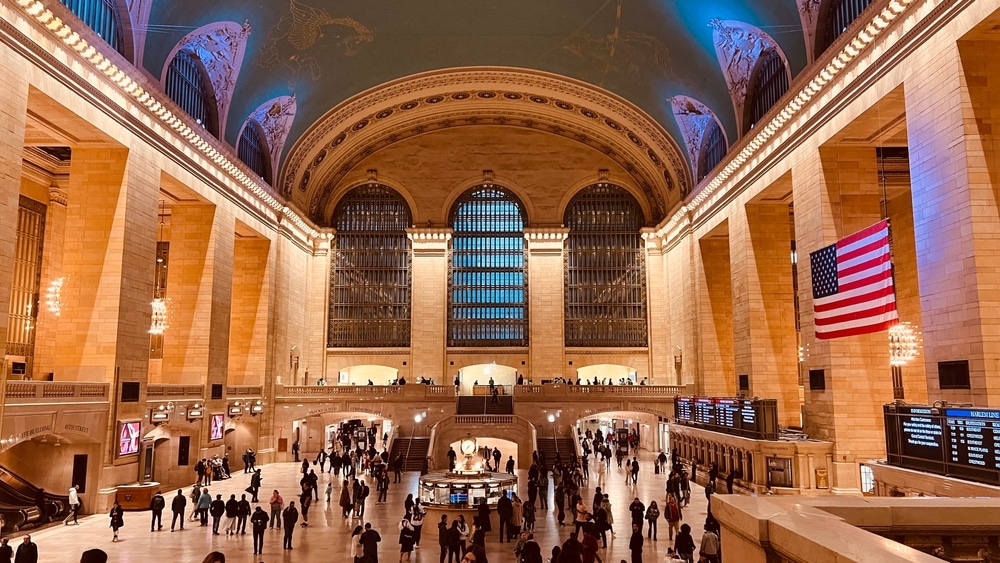Grand Central Terminal, commonly known as Grand Central Station, is one of New York City’s most iconic architectural landmarks. Despite its majestic façade and popularity as a tourist site and transit hub, the station has a troubling history of asbestos use. The use of the carcinogenic material during its construction and subsequent renovations exposed many workers to the risk of malignant mesothelioma, asbestos-related lung cancer, and asbestosis.

About Grand Central Station
Located at 42nd Street and Park Avenue in Midtown Manhattan, Grand Central Terminal is a commuter rail terminal and one of the world’s most famous train stations.
It serves as the southern terminus of the Metro-North Railroad’s Harlem, Hudson, and New Haven Lines. The structure that stands on the site today was not the first. Built in 1913 in classic Beaux-Arts style, it replaced an earlier building.[1]
Grand Central covers 48 acres and contains 44 platforms, more than any other railroad station in the world. It boasts many distinctive and unique features, including the iconic four-faced clock in the main concourse, the celestial ceiling mural, and its grand staircases.
Beyond being a transportation hub, Grand Central is home to numerous shops, restaurants, and exhibition spaces, making it a popular destination in its own right.[2]
Grand Central Terminal sees approximately 750,000 visitors every day, including both commuters and tourists. More than an integral piece of New York City’s transportation infrastructure, it’s also a historic landmark that has been featured in countless films, television shows, and literary works.
In 1978, the terminal was designated a National Historic Landmark, cementing its status as an architectural treasure worthy of preservation.[1]
History of Grand Central Station, Its Construction, and Renovations Through the Years
The history of Grand Central Terminal spans more than a century, with its construction and later renovations coinciding with periods when asbestos use was standard practice in the building industry.[1]
The original Grand Central Depot was built between 1869 and 1871 by railroad tycoon Cornelius Vanderbilt. By the early 1900s, the increasing popularity of rail traffic and a tragic accident in 1902 prompted plans for a complete rebuilding of the terminal.
Construction of the current complex began in 1903 and was completed in 1913. It cost $80 million (equivalent to approximately $2.3 billion today).[1]
During this first construction period (1903-1913), asbestos was commonly used in the construction of all types. Valued for its strength, durability, low cost, and easy accessibility, it was also known for its fire-resistant properties.
This was especially important for a steam locomotive terminal where fire hazards were a significant concern. The structure’s architects, Reed and Stem, along with Warren and Wetmore, made extensive use of asbestos insulation throughout the building.[1]
Since the terminal’s initial construction, it has undergone several major renovations, including:[1]
- 1920s-1930s. Modifications were made to accommodate the growth in passenger traffic.
- 1954-1967. Significant renovations occurred, including updates to mechanical systems and infrastructure.
- 1976-1978. After the terminal was named a historic landmark, some restoration work began.
- 1990-1998. A $425 million restoration project was undertaken, focusing on both aesthetic and structural elements. By the time this renovation took place, the public was aware of the dangers of asbestos, and a significant part of the restoration was dedicated to asbestos abatement. This undertaking was one of the largest asbestos abatement projects in New York City history.[3]
- 2000s-2020s. Ongoing maintenance and smaller renovation projects have continued under strict asbestos protocols.
Where Was Asbestos Used in Grand Central Station?
Asbestos was incorporated into numerous construction elements and systems throughout Grand Central Terminal. It was found throughout the structure. The primary locations and applications of asbestos in Grand Central included:
- Thermal Insulation. Asbestos was used to insulate steam pipes, heating systems, and boilers throughout the terminal. With miles of piping running through the building to support its heating and cooling needs, this represents one of the most significant sources of asbestos.
- Electrical Systems. The terminal’s vast electrical infrastructure utilized asbestos for its fire-resistant properties, particularly around wiring, electrical panels, and generators.
- Structural Components. Asbestos-containing materials were incorporated into various structural elements, including:
- Fireproofing sprayed on steel beams and columns
- Ceiling and wall plaster
- Floor tiles and adhesives
- Decorative elements and moldings
- Acoustical Materials. To manage noise in the busy terminal, asbestos was used in acoustical ceiling tiles and sound-dampening materials.
- Mechanical Rooms. Areas housing equipment had particularly high concentrations of asbestos, used to fireproof and insulate machinery.
- Track Areas. The infrastructure supporting the tracks and platforms contained significant amounts of asbestos insulation.
- Public Areas. Even in the grand public spaces, asbestos was used in materials including plaster, decorative elements, and flooring.
During the renovation in the 1990s, approximately 400 tons of asbestos-containing materials were removed. This is a stark indication of the sheer scale of asbestos use throughout the structure.
Despite this extraordinary effort, there’s a good chance that some asbestos remains in the building, though it is probably encapsulated within inaccessible areas of the building. To guard against the risk of future exposure, the city has established ongoing monitoring programs.
Who Was Exposed to Asbestos at Grand Central Station?
Asbestos exposure at Grand Central Terminal represented a risk to people working in a wide range of professions and reasons for being in the building. Those at risk include:
- Construction Workers (1903-1913). The original construction workforce faced a significant risk of asbestos exposure. Unaware of the material’s dangers, they installed asbestos-containing materials throughout the terminal without any protective equipment. This group of workers included insulators, pipefitters, electricians, carpenters, plasterers, and general laborers.
- Maintenance Personnel. Throughout the terminal’s history, maintenance workers who repaired, replaced, or worked near asbestos materials were at high risk. This group includes:
- Pipefitters, steamfitters, and plumbers
- Electricians
-
- General maintenance staff
- Renovation Workers. Each major renovation project before modern asbestos regulations had the potential to expose workers to significant amounts of asbestos fibers. The renovations that took place from the 1950s to the 1970s happened before comprehensive asbestos safety regulations were implemented.
- Railroad Employees. Train conductors, station agents, ticket sellers, and other terminal employees who worked in or traveled through the building every day for years or decades experienced prolonged exposure, though typically at lower concentrations than construction or maintenance workers.
- Abatement Workers. During the 1990s renovation, asbestos removal was conducted under regulated conditions, but workers involved in abatement still face potential exposure, despite protective equipment and safety protocols.
- Commuters and Visitors. Commuters who passed through the terminal regularly during renovation periods when asbestos fibers may have been airborne could have experienced low-level exposure. This risk is generally considered to be lower than that of workers directly handling asbestos-containing materials.
- Nearby Office Workers. Grand Central is home to multiple administrative offices, and workers within those offices may have experienced prolonged low-level exposure, especially if their workspaces contained asbestos materials or were near maintenance activities.
The risk to these individuals varied depending on their occupation, the amount of time they spent in the terminal, their proximity to asbestos-containing materials, and whether those materials were disturbed, as damage to asbestos causes it to break down into microscopic particles that are easily inhaled.
Legal Action Taken by Workers Exposed to Asbestos at Grand Central Terminal
By the 1990s, many of the workers who had been exposed to asbestos at Grand Central Terminal began showing troubling symptoms of asbestos-related diseases.
With the newly released knowledge that asbestos companies had known that the material was dangerous, but failed to take action to protect themselves. Many workers filed suit against the manufacturers, distributors, and others involved in its presence at the station:
- 140 pipefitters and others who had worked to remove asbestos wrap from 60 miles of underground in the tunnels below Grand Central Station, filed suit seeking the right to sue under Federal railroad law for emotional distress and medical monitoring.[4]
- In 2013, William Krauss and his wife filed suit against 3M and other asbestos manufacturers following his diagnosis of asbestos-related lung cancer. Mr. Krauss had been a union sheet-metal worker replacing air conditioning equipment and installing flooring from approximately 1952 through 1959 in New York, including at the Grand Central Terminal. In his deposition, he recounted having been exposed to many asbestos-containing products through the course of his career, including floor tiles and asbestos-containing gaskets.
- Paul Vickers, a welder for Metro-North Commuter Railroad Co., filed a mesothelioma lawsuit against Racine Railroad Products, Inc., and others, accusing the companies of negligence in having exposed him to asbestos during his 30-year career as a welder at Grand Central Station. He was seeking $2 million in compensatory damages and $20 million in punitive damages.[5]
What Is the Risk of Asbestos Exposure?
Exposure to asbestos presents serious health risks that typically don’t begin to show symptoms until decades after the exposure takes place. The most common and deadly asbestos-related diseases include:
- Malignant Mesothelioma. This aggressive and deadly form of cancer affects the lining of the lungs (pleural mesothelioma) or, less commonly, the abdomen (peritoneal mesothelioma). Even brief exposure to asbestos can result in mesothelioma, with symptoms typically appearing 40-50 years after exposure.
- Asbestos-Related Lung Cancer. Asbestos exposure significantly increases the risk of lung cancer, with the risk multiplied for those who also smoke. Like mesothelioma, asbestos-related lung cancer has a long latency period, typically developing decades after exposure.
- Asbestosis. This progressive, incurable respiratory disease is caused by scar tissue that forms in the lungs after asbestos fibers are inhaled. This disease usually follows heavy, prolonged exposure to asbestos and causes symptoms such as shortness of breath, persistent dry cough, chest tightness, and, eventually, heart failure in severe cases.
- Other Asbestos-Related Conditions. Asbestos exposure can also cause pleural plaques, pleural thickening, COPD, and pleural effusions. While less deadly than the conditions above, these illnesses lead to reduced lung function and severely affect quality of life.
The factors that influence the likelihood of developing any of these asbestos-related diseases include:
- Dose. Higher concentrations and longer durations of exposure increase risk.
- Type of Asbestos. Some varieties, particularly blue (crocidolite) and brown (amosite) asbestos, are more dangerous than white (chrysotile) asbestos, though all types can cause disease.
- Smoking. Tobacco use increases the risk of asbestos-related lung cancer.
- Time Since Exposure. The risk of developing asbestos-related diseases increases with time, peaking 30-40 years after exposure.
For Grand Central Terminal workers, particularly those involved in construction, maintenance, and renovations before modern safety processes were introduced, the risk of developing these conditions is significant. Sadly, because of the disease’s long latency period, many people exposed decades ago are still at risk of being diagnosed.
What Can People Sickened by Asbestos at Grand Central Station Do?
If you’ve been diagnosed with malignant mesothelioma or another asbestos-related disease and you believe your illness is related to asbestos exposure at Grand Central Terminal, you have several options.
After seeking medical care, meeting with an experienced asbestos attorney will help you learn about the legal remedies available to you.
This may include filing a personal injury lawsuit against the companies whose asbestos-containing products you were exposed to or submitting claims to the asbestos trust funds set up by manufacturers whose asbestos liabilities forced them into bankruptcy.
By seeking guidance from a lawyer who specializes in asbestos claims, you’ll get the benefit of their experience, deep knowledge, and extensive resources, including volumes of case history.
Though you may only be looking for information about your options, it’s important to note that every state has its own time limits known as statutes of limitations for filing personal injury claims after diagnosis.
A lawyer will be able to tell you exactly what your deadline is based on the date of your diagnosis, so you’ll be able to make an informed decision in consultation with your family.
References
- The New York Preservation Archive Project. ( n.d.) Grand Central Terminal.
Retrieved from: https://www.nypap.org/preservation-history/grand-central-terminal/ - Grand Central Terminal. (n.d.). About.
Retrieved from: https://grandcentralterminal.com/about/ - Ziegler, B. (1998, April 8). Grand Central Terminal Undergoes Huge Renovation to Become Upscale. Wall Street Journal.
Retrieved from: https://www.wsj.com/articles/SB891997673894845500 - Gross, Jane. (1997, June 2). Supreme Court to Rule on Pipe Fitters, Long Bathed in Railroad’s Asbestos. The New York Times.
Retrieved from: https://www.nytimes.com/1997/06/02/nyregion/supreme-court-to-rule-on-pipe-fitters-long-bathed-in-railroad-s-asbestos.html - Hornbeck, E. (2011, March 7). Liberty Seeks to Avoid Covering $22M Asbestos Suit. Law360.
Retrieved from: https://www.law360.com/articles/230128/liberty-seeks-to-avoid-covering-22m-asbestos-suit

Terri Heimann Oppenheimer
WriterTerri Oppenheimer has been writing about mesothelioma and asbestos topics for over ten years. She has a degree in English from the College of William and Mary. Terri’s experience as the head writer of our Mesothelioma.net news blog gives her a wealth of knowledge which she brings to all Mesothelioma.net articles she authors.

Dave Foster
Page EditorDave has been a mesothelioma Patient Advocate for over 10 years. He consistently attends all major national and international mesothelioma meetings. In doing so, he is able to stay on top of the latest treatments, clinical trials, and research results. He also personally meets with mesothelioma patients and their families and connects them with the best medical specialists and legal representatives available.


